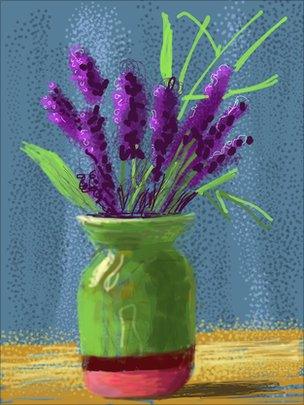David Hockney's instant iPad art
- Published
"Who wouldn't want one? Picasso or Van Gogh would have snapped one up," the artist David Hockney tells me at the opening of his latest show in Paris called Fleurs Fraiches, or Fresh Flowers.
The boyish grand old man of pop art with silver hair and lambent eyes is well known for his recent conversion to the iPhone and iPad for his work.
Now, several of the tablet computers have been turned into technological canvases to display his latest work at an exhibition
Hockney, dressed in a bespoke suit made with pockets large enough to fit an iPad, seems most amused by it all.
He chuckles at the irony of this very high-tech art housed in a lush and ornate gallery a stone's throw from the Eiffel Tower.
More than a dozen iPads reveal the drawings, many of them flowers, with the artist's signature flair and beguiling simplicity.
The title is apt as the images on the iPads are "refreshed" during the course of the show; new flowers replacing the earlier ones.
Animated art
Hockney is no stranger to digital - or computer - art. But in his first experiments 20 years ago, he found the process slow and frustrating.

The displayed images are regularly updated
"Drawing is rather like playing chess: your mind races ahead of the moves that you eventually make,' he says.
He found that the computer always played catch-up, there was always a delay.
The speed of modern computers makes working on them now far more attractive, he says.
They also come with other appeals, he adds.
For example, the iPad has a function that animates the drawings
"I can see just how I've made the strokes to form the drawings," he says.
It has also given him a new way of sharing his creations.
Fleurs Fraiches has its origins in smaller drawings that Hockney made on his iPhone and then e-mailed to friends.
After a short while he'd produced hundreds of drawings, loving them for their immediacy, and for the instant responses and critiques from those who received them.
"You can make a drawing of the sunrise at 6am and send it out to people by 7am."
Real touch
When he's worked with computers in the past he has printed the images and framed them before hanging them on the gallery wall.
But for the Paris show, he did not want to display copies. Instead, he wants visitors to see the works just as he created them with his fingers on the various iPads.
Visitors to the show are shown this process up close.
Inside the cathedral-like space, with low-lighting to enhance the luminosity of the images on the iPad, visitors are also treated to a short film in which he snappily draws the Eiffel Tower in real time.
Hockney uses several applications, including one called Brushes, to draw the pictures.
He prefers to use his fingers rather than a stylus. Different fingers are used for varying effects, and even though he is right-handed, he often draws with his left hand, giving the final works a quality that he'd have difficulty replicating with his stronger arm.
The results throws up questions about the very nature of "originals" and "reproductions", and the value - aesthetic and monetary - of the work. As yet, Fresh Flowers are not for sale.
The technology brings a new dimension to the gallery, and both he and the curator Charlie Scheips, believe that they are at the beginning of an artistic revolution for professionals and amateurs alike.
"Even though some of the tools may be too advanced for the novice or amateur, they are still extraordinary and well worth exploring," says Hockney.
And although the colours may not be as rich as that which he might conjure from oils with a paint brush and palette he still marvels at what can be achieved.
"It's a real privilege to make these works of art through digital tools which mean you don't have the bother of water, paints, and the chore of clearing things away," he says.
"You know sometimes I get so carried away, I wipe my fingers at the end thinking that I've got paint on them."
Colin Grant interviewed David Hockney for Digital Planet on the BBC World Service. You can also see more from the artist on Click, external from 12th November on BBC World News and the BBC News Channel
- Published20 October 2010